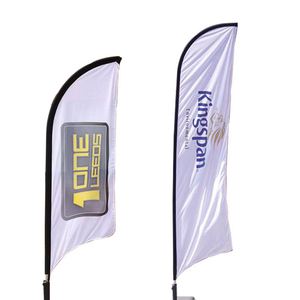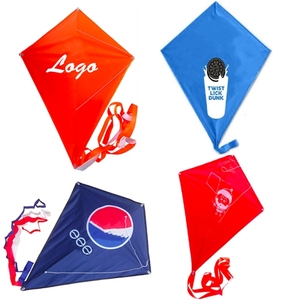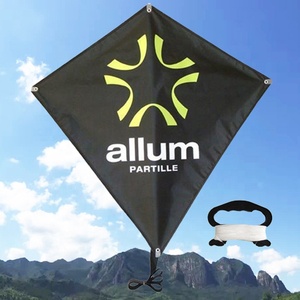(448 products available)




















































































































































































Kite advertising comes in many different forms, each with its unique design, purpose, and usage. Here are some common types of kites used for advertising:
Box Kites
Box kites are stable and handle well in the wind. They have a three-dimensional rectangular box structure. Their stability makes them suitable for high-altitude advertising. Therefore, they can be used for any advertisement that needs to be seen from a distance.
Delta Kites
Delta kites have a triangular shape. They are easy to fly in a wide range of wind conditions. Delta kites are popular for promotional and advertising uses because they are simple to construct and fly. They are also lightweight and can be flown with minimal wind required.
Foil Kites
Foil kites have a multi-chamber design that inflates when the kite is in the air. They are very efficient in low winds because of their large surface area. Foil kites are suitable for advertising purposes that require to be flown in low wind.
Single-Line Kites
Single-line kites are easy to assemble and do not require much expertise to fly. These kites are suitable for advertising targeting children or casual kite flyers. Such kites can be brightly colored or come in various shapes, such as animals or objects.
Stunt Kites
Stunt kites are dual-line or quad-line kites that can be maneuvered for tricks and stunts. These kites are complex and have a lightweight frame. They are suitable for kite festivals and events where people engage in stunts. Stunt kites can also be used for advertising to attract consumers' attention.
Spool Kites
Spool kites have a simple design and come in circular or semi-circular shapes. They are easy to make and fly. Spool kites are suitable for local events, schools, and functions where a simple and economical way of advertising is needed.
Parafoil Kites
Parafoil kites have a soft design without a rigid frame. These kites have a design that allows them to open up when in the air. They are suitable for advertising functions that require lightweight and portable kites.
When selecting kites for sale, business owners should consider the material, design, size, and skill level.
Kite material refers to the fabric used to make it. It determines how durable the kite is. Common fabric materials include polyethylene, ripstop nylon, and paper. Kites made with polyethylene and paper are less costly than those with ripstop nylon. They are also less durable. Kites can also be made with other materials such as mylar and plastic. Mylar kites, which are metallic, have dazzling colors and catch the sunlight well. They are great for advertising purposes. Plastic kites are lightweight and easy to fly, but they are less durable in windy conditions.
Design is essential when choosing kites for sale. Buyers should get kites in various shapes, colors, and graphics. Traditionally, kites come in two primary shapes, which are the diamond and the box. Kites with vibrant colors and interesting graphics can attract attention. Businesses should also consider getting kites with banners, logos, or messages. Such kites can be used for marketing events.
The size of the kite determines how visible it is. Large kites are easier to see from a distance. However, they require a lot of space to fly. On the other hand, small kites are portable and easier to handle, but they may not be very visible.
Kite flying requires some skills. Beginners may find it challenging to fly certain types of kites. Therefore, business owners should stock kites that are easy to assemble and fly. They should also get kites with detailed instruction manuals. Moreover, they can get kites in different categories according to the skill level of the flyer. For example, stable kites are perfect for beginners, while trick kites are for advanced flyers.
Material Safety:
Ensure the materials used for constructing kites are non-toxic and devoid of hazardous substances. This protects not only those who make it but also those who play with and fly it.
Structural Integrity:
The framework of the kite should be firm enough to withstand windy conditions. This helps avoid accidents caused by flying pieces or collapsing structures.
Line Strength:
Using strong and durable lines reduces the risk of breakage while in flight. This ensures safety for people on the ground as well as preventing the loss of the kite.
Wind Conditions:
Kite flying should be done under appropriate weather conditions. This means avoiding extreme winds or storms to ensure safety and keeping a lookout for changing weather patterns.
Flying Rules:
Advertisers should follow all set regulations concerning kite flying. These include maintaining a distance from power lines, other flying objects, and structures. This reduces the risk of accidents and injuries.
Durability:
For a kite to be good, it must be made of strong materials like fiberglass or plastic that can withstand different weather conditions.
Design:
A kite with a good design is more stable when it is flying. It needs to have a balance between the frame and the shape to catch the wind properly.
Ease of Assembly:
A quality kite should be easy to put together and take apart, featuring clear instructions and parts that fit well without needing specialized tools.
Safety:
While flying a kite, one should consider the lines and bridle system. These should be properly made to avoid breaking and causing the kite to crash.
Wind Range:
A good kite should perform well in light and moderate winds. This means it can be used in different weather conditions without flying too high or too low.
What materials are used to make advertisement kites?
Kite advertising kites are typically made of durable materials like nylon, polyethylene, or ripstop fabric for the sail, which can withstand wind and outdoor conditions. The frames are often constructed from lightweight yet strong materials such as fiberglass or carbon fiber.
How long can advertisement kites last?
The lifespan of advertisement kites varies based on materials, weather conditions, and usage. Those constructed from durable materials can last several months or even years if maintained and used properly.
Are advertisement kites reusable?
Yes, advertisement kites can be reused, especially if they are made from durable materials and have a timeless design. They can be stored and repaired if necessary, then used for future events or promotions.
How are advertisement kites stored when not in use?
Kite advertising storage when not in use involves carefully folding and packing them in a storage bag or case. They should be kept in a dry, cool place to avoid exposure to extreme temperatures or moisture, which can damage the materials.